Non so se scegliere ricami e stampa per l'abbigliamento personalizzato? Reniamolo semplice. Il ricamo aggiunge una finitura di classe e duratura, Perfetto per i loghi su giacche o tappi. Stampa, d'altro canto, è l'ideale per grassetto, disegni colorati e funziona alla grande per magliette o ordini sfusi.
Ogni metodo ha i suoi punti di forza, Quindi la scelta giusta dipende dal tuo progetto. In questo articolo, Abbatteremo le differenze, Aiutarti a vedere quale si adatta meglio alle tue esigenze. Pronto a scoprirlo? Immergiamoci!
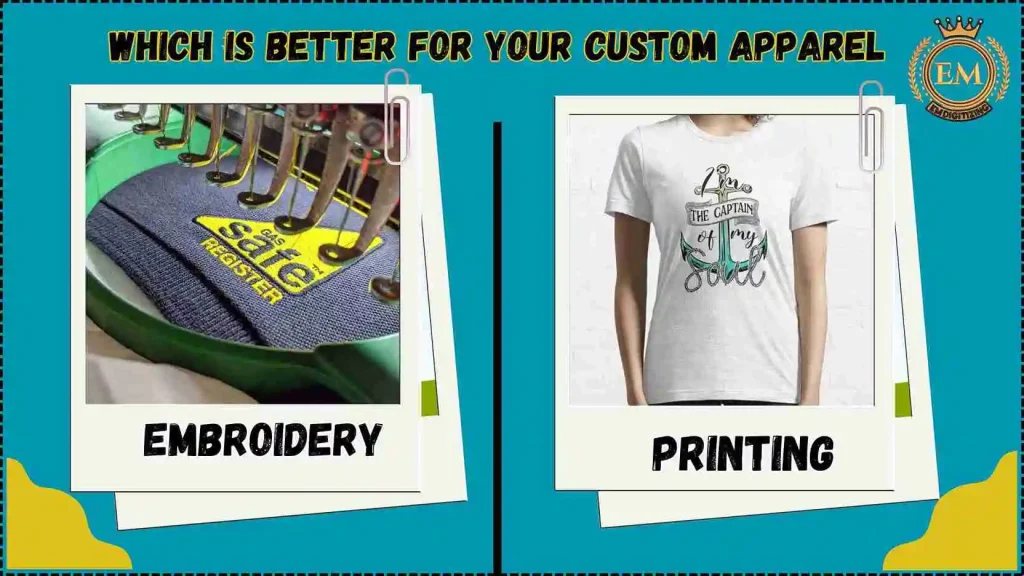
Ricamo vs stampa: Che è meglio per il tuo abbigliamento personalizzato?
Cos'è il ricamo?
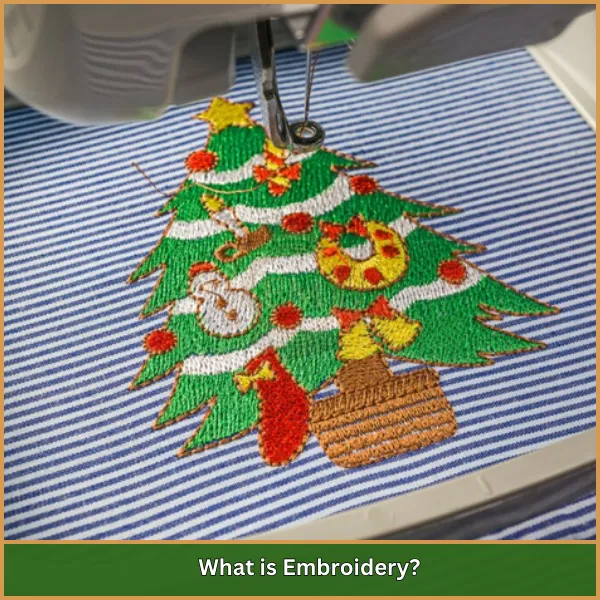
È l'arte di tessuto decorativo o altri materiali che utilizzano un ago per applicare il filo o il filo. Questo processo può creare progetti intricati, modelli, o loghi, Aggiunta di un look strutturato e premium ai capi.
Vantaggi:
- Durata: I disegni ricamati sono di lunga durata e resistenti all'usura.
- Aspetto professionale: Fornisce una qualità di alta qualità, aspetto lucido, Ideale per l'abbigliamento aziendale.
- Versatilità: Funziona bene su una varietà di tessuti, compresi materiali spessi e strutturati come cappelli e giacche.
Limitazioni:
- Costo: Generalmente più costoso della stampa, Soprattutto per progetti di grandi dimensioni.
- Complessità progettuale: Dettagli e gradienti raffinati sono più difficili da raggiungere.
- Produzione di massa: Potrebbe non essere conveniente per ordini ad alto volume con progetti intricati.
Cosa sta stampa?
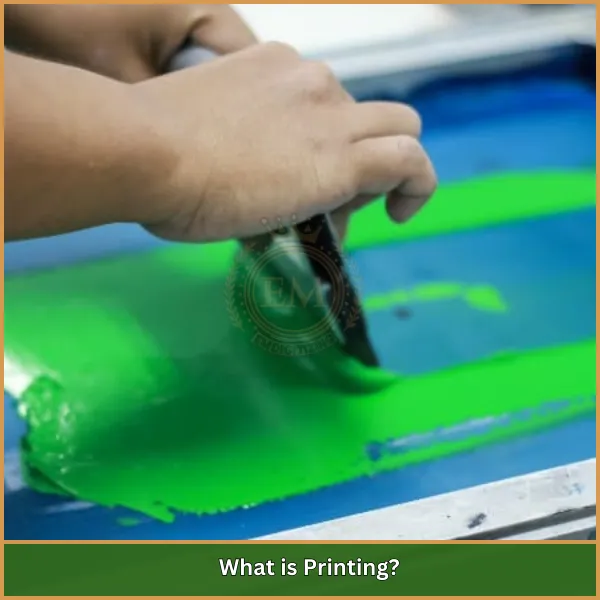
È il processo di trasferimento di progetti, loghi, o motivi sul tessuto usando tecniche specializzate. Offre flessibilità per la creazione di design vibranti e dettagliati, rendendolo una scelta popolare per l'abbigliamento personalizzato.
Vantaggi:
- Conveniente per gli ordini sfusi: Ideale per la produzione su larga scala con un costo minimo per articolo.
- Flessibilità di progettazione: Perfetto per disegni intricati e colorati, compresi gradienti e dettagli fotografici.
- Produzione rapida: Tempo di consegna più veloce rispetto ai ricami per grandi ordini.
Limitazioni:
- Durata: I disegni stampati possono svanire, crepa, o sbucciare nel tempo con un lavaggio frequente.
- Limitazioni del tessuto: Funziona meglio in piano, tessuti lisce come cotone o poliestere.
- Appello premium: Può non perdere l'aspetto di fascia alta del ricamo per determinate applicazioni.
Confronto: Ricamo vs stampa
Quando si decide tra ricamo vs stampa dello schermo, È essenziale capire le differenze uniche nella durata, costo, e flessibilità di progettazione per scegliere l'opzione migliore per l'abbigliamento personalizzato.
- Durata
- Aspetto e trama
- Costo e scalabilità
- Idoneità per tessuti diversi
- Complessità progettuale
1. Durata
Il ricamo è altamente resistente, con design che rimangono intatti anche dopo anni di lavaggio e uso intenso. I punti non sbiadiscono o sbucciano, rendendolo una scelta eccellente per l'uso a lungo termine. In confronto, La stampa dello schermo è resistente ma più inclini a cracking, peeling, o sbiadire nel tempo, soprattutto con lavaggi frequenti o cura impropria.
2. Aspetto e trama
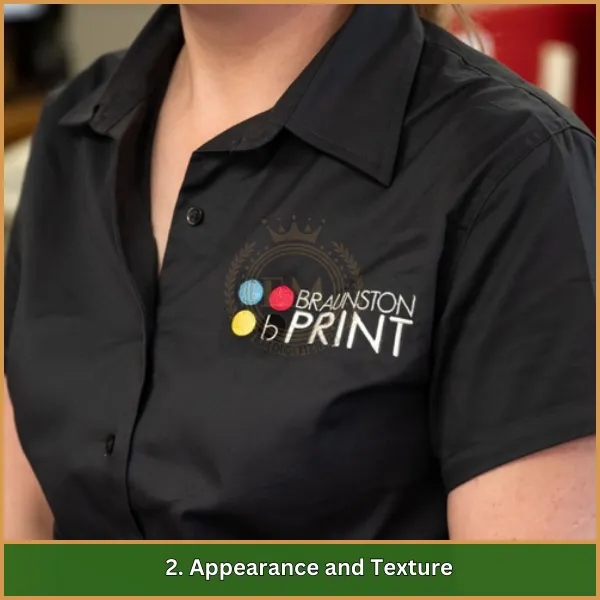
Ricamo vs stampa offre due opzioni di personalizzazione uniche. Il ricamo fornisce un rialzato, Look strutturato che aggiunge una sensazione professionale e premium, rendendolo perfetto per l'abbigliamento aziendale o l'abbigliamento di fascia alta. Stampa, d'altro canto, offre un liscio, design piatto con vibrante, colori accattivanti ma non offre la stessa consistenza o profondità dei ricami.
3. Costo e scalabilità
La stampa vs ricamo offre diverse considerazioni sui costi. Il ricamo è in genere più costoso, Soprattutto per design grandi o dettagliati, A causa del tempo e dello sforzo manuale coinvolto. Per ordini di massa, I costi possono aumentare significativamente. Stampa, però, è più conveniente per la produzione ad alto volume, Poiché i costi di installazione sono distribuiti su quantità maggiori, rendendolo un'opzione economica per la stampa in blocco.
4. Idoneità per tessuti diversi
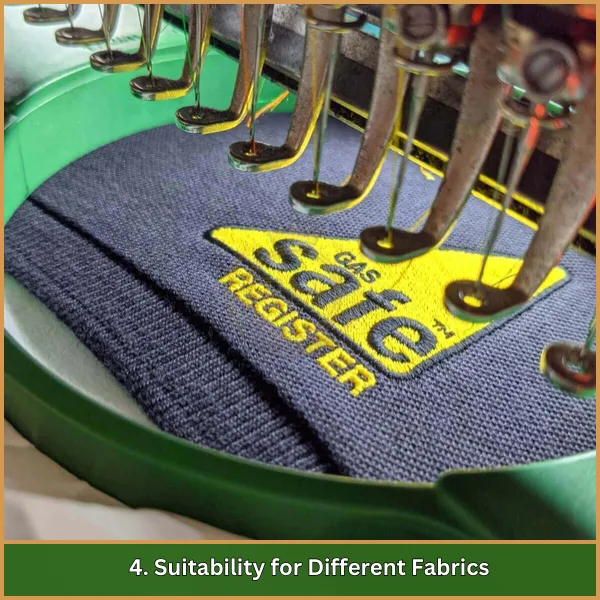
Il ricamo è versatile e funziona bene più spesso, tessuti testurizzati come cappelli, giacche, e asciugamani, Mantenere la sua integrità del design su materiali difficili. La stampa dello schermo si comporta meglio su Smooth, tessuti piatti come cotone e poliestere, Garantire una finitura coerente, sebbene possa lottare con materiali strutturati.
5. Complessità progettuale
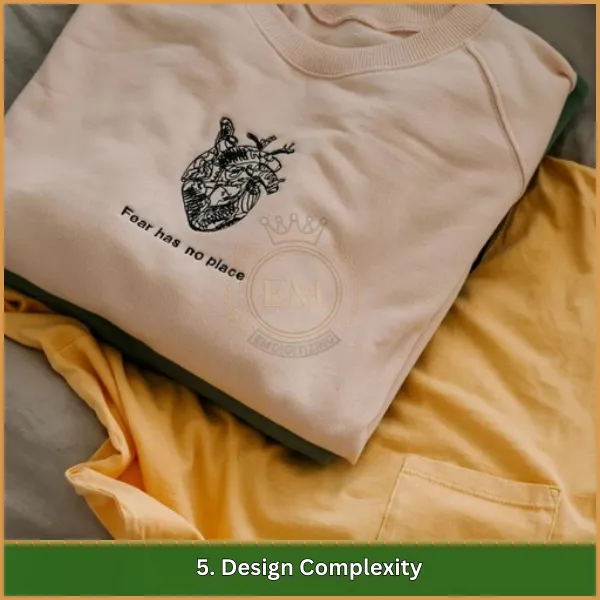
Ricamo vs stampa evidenzia due metodi distinti per la personalizzazione. Il ricamo è il migliore per semplice, loghi o testo in grassetto con un numero limitato di colori a causa delle limitazioni delle cuciture. In contrasto, La stampa eccelle nel complesso di gestione, disegni intricati con più colori, gradienti, e dettagli fotografici, Fornire una maggiore flessibilità creativa.
I migliori casi d'uso per il ricamo
Quando si confrontano la stampa schermata vs ricamo, Il ricamo si distingue per la sua durata e l'aspetto professionale, rendendolo una scelta popolare per applicazioni specifiche.
- Abbigliamento aziendale: Perfetto per le uniformi, camicie, e giacche per creare un look professionale e premium.
- Cappelli e berretti: Il ricamo funziona meglio su materiali strutturati come cappelli, Fornire un design strutturato e di lunga durata.
- Capispalla: Ideale per le giacche, felpe con cappuccio, e altri tessuti spessi che richiedono decorazioni resistenti.
- Articoli speciali: Comunemente usato su asciugamani, borse, e coperte per una sensazione lussuosa e personalizzata.
- Loghi e monogrammi: Meglio per grassetto, Disegni semplici che migliorano la visibilità del marchio con una finitura di fascia alta.
I migliori casi d'uso per la stampa
Nel dibattito sul ricamo vs stampa, La stampa eccelle nella creazione di vibranti, Design dettagliati a un costo inferiore, soprattutto per progetti su larga scala o intricati.
- Magliette e felpe con cappuccio: Perfetto per creare disegni colorati e dettagliati sull'usura casual.
- Ordini di massa: Economico per grandi quantità, rendendolo ideale per eventi promozionali e omaggi.
- Disegni complessi: Meglio per motivi intricati, gradienti, e opere d'arte multicolore.
- Tessuti leggeri: Funziona bene su materiali lisci e sottili come il cotone o il poliestere.
- Merce personalizzata: Ideale per la creazione di design unici su tote bag, tazze, e altri articoli promozionali.
Conclusione
Quando si tratta di ricamo vs stampa, La scelta dipende dalle tue esigenze. Per un premio, sguardo duraturo, Il ricamo è l'ideale. Se stai cercando audace, Disegni colorati per magliette o oggetti sfusi, La stampa è la strada da percorrere.
All'EMDigitizing, Siamo specializzati nel dare vita ai tuoi disegni con il nostro digitalizzazione del ricamo e servizi di arte vettoriale. I nostri prezzi sono imbattibili, E garantiamo la qualità di prim'ordine con tempi di consegna superveloni. Voglio vedere il tuo design prima che venga finalizzato? Nessun problema: offriamo un'opzione di anteprima per ogni ordine! Più, se sei un cliente per la prima volta, ti godrai un fantastico 50% sconto.
Facci prendere la seccatura dai tuoi progetti personalizzati. Inizia con EMDigitalizzazione oggi e sperimenta il meglio del settore!
Domande frequenti
Se vuoi qualcosa che dura, Il ricamo vince il gioco della durata. Tiene contro il lavaggio e l'usura senza perdere il suo fascino, A differenza della stampa, che può svanire o rompersi nel tempo.
Per risparmiare denaro, La stampa prende il comando. È conveniente per grandi quantità, Mentre i ricami possono diventare costosi, Soprattutto per i progetti grandi o dettagliati.
Disegni complessi con molti colori o gradienti? La stampa è il tuo punto di riferimento. Il ricamo è fantastico, Ma è più adatto a design più semplici.
Non esattamente. Il ricamo splende su tessuti più spessi come giacche e cappelli. La stampa funziona come magia su materiali lisci come cotone o poliestere.
Se la velocità è la tua priorità, La stampa è più veloce, soprattutto per ordini all'ingrosso. Il ricamo richiede un po 'più di tempo a causa delle cuciture dettagliate.
